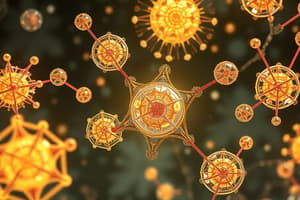Podcast
Questions and Answers
Which formula represents the molecular composition of glucose?
Which formula represents the molecular composition of glucose?
- C6H10O5
- C12H22O11
- CH2O
- C6H12O6 (correct)
The law of conservation of mass states that mass can be created during a chemical reaction.
The law of conservation of mass states that mass can be created during a chemical reaction.
False (B)
What is the term used to describe the combining capacity of an element?
What is the term used to describe the combining capacity of an element?
valency
Sodium chloride is the chemical name for the compound represented by the formula ______.
Sodium chloride is the chemical name for the compound represented by the formula ______.
Match the following compounds with their correct naming conventions:
Match the following compounds with their correct naming conventions:
Which of the following statements best describes the law of definite proportions?
Which of the following statements best describes the law of definite proportions?
Empirical formulas show the actual number of atoms in a molecule.
Empirical formulas show the actual number of atoms in a molecule.
Identify the empirical formula for glucose.
Identify the empirical formula for glucose.
what is an ion?
what is an ion?
Flashcards
Atoms
Atoms
Fundamental building blocks of matter, indivisible by chemical means.
Molecules
Molecules
Formed when two or more atoms chemically bond together.
Atomic Number
Atomic Number
The number of protons in an atom defines the element.
Mass Number
Mass Number
Signup and view all the flashcards
Chemical Formula
Chemical Formula
Signup and view all the flashcards
Ionic Compounds
Ionic Compounds
Signup and view all the flashcards
Law of Conservation of Mass
Law of Conservation of Mass
Signup and view all the flashcards
Valency
Valency
Signup and view all the flashcards
Study Notes
Atoms and Molecules
- Atoms are the fundamental building blocks of matter, indivisible by chemical means.
- Molecules are formed when two or more atoms chemically bond together.
- Molecules can be composed of the same type of atom (e.g., O2) or different types of atoms (e.g., H2O).
- The structure of a molecule dictates its properties and behavior. Different arrangements of atoms lead to different molecules.
Structure of Atoms
- Atoms consist of a nucleus containing protons and neutrons, surrounded by orbiting electrons.
- Protons are positively charged, neutrons are neutral, and electrons are negatively charged.
- The number of protons defines the element. This number is also known as the atomic number (e.g., Z for Hydrogen = 1).
- The mass of an atom is mainly determined by the protons and neutrons in the nucleus. The sum of the protons and neutrons in an atom's nucleus is the mass number (A).
- Electrons occupy different energy levels or shells around the nucleus.
- The outermost shell of electrons is called the valence shell.
Formulae
- Chemical formulas represent the composition of molecules.
- They use symbols of the elements to show the types of atoms present and subscripts to indicate the number of each type of atom in the molecule (e.g., H2O).
- Molecular formulas depict the actual number of atoms in a molecule (e.g., C6H12O6).
- Empirical formulas show the simplest whole-number ratio of atoms in a compound (e.g., CH2O for glucose).
Names of Compounds
- Compounds are named according to established nomenclature rules.
- The rules depend on the type of compound (ionic or covalent).
- Ionic compounds are named by stating the cation (positive ion) name first, followed by the anion (negative ion) name (e.g., sodium chloride, NaCl).
- Covalent compounds are named using prefixes to indicate the number of each type of atom (e.g., carbon dioxide, CO2).
Laws of Chemical Combinations
- Law of Conservation of Mass: Mass is neither created nor destroyed during a chemical reaction.
- Law of Definite Proportions: A given compound always contains the same elements in the same proportions by mass.
- Law of Multiple Proportions: When two elements combine to form more than one compound, the masses of one element that combine with a fixed mass of the other element are in ratios of small whole numbers.
Valency
- Valency refers to the combining capacity of an element.
- It represents the number of electrons an atom can gain, lose, or share to form a chemical bond with another atom.
- Valency is often related to the number of electrons in the valence shell.
- Valency is expressed as a numerical value, representing the power of combination with other elements.
Studying That Suits You
Use AI to generate personalized quizzes and flashcards to suit your learning preferences.




